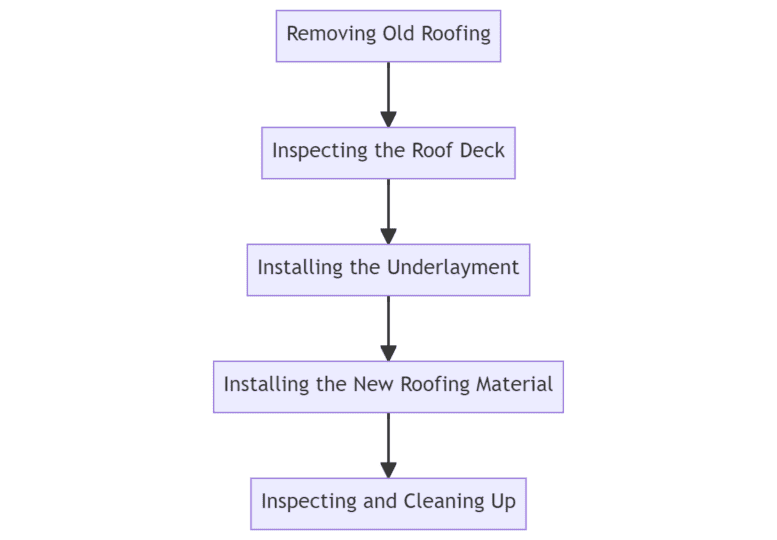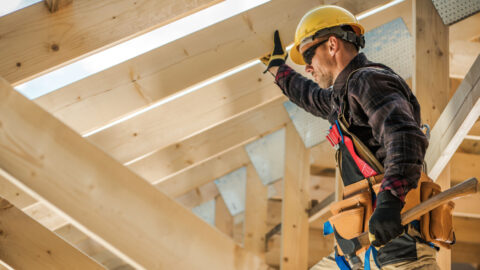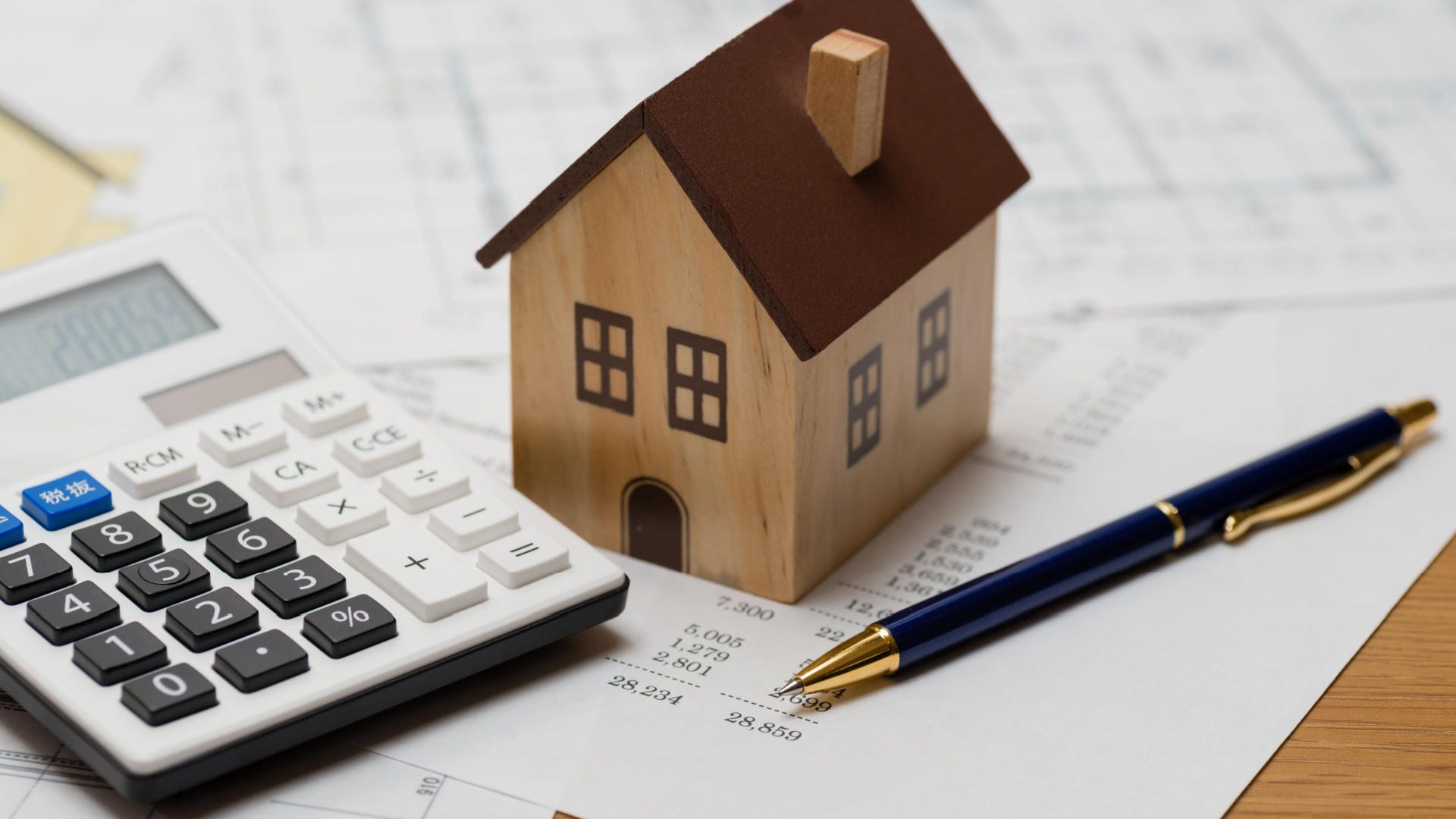Replacing your home’s roof is a significant investment that requires careful consideration. From understanding the signs of roof deterioration to choosing the right materials and finding a reliable contractor, our comprehensive guide will walk you through every step of the roof replacement process.
Recognizing the Signs Your Roof Needs Replacement
Early detection of roof issues can save you from costly repairs down the line. Here are key indicators that your roof may need replacement:
- Age of the Roof: Most asphalt shingle roofs last between 20 to 25 years. If your roof is over two decades old, it might be time to consider replacement.
- Shingle Issues: If you notice shingles that are curled, broken, missing, or losing granules, your roof may be nearing the end of its lifespan.
- Visible Leaks and Water Damage: Check your attic for signs of water infiltration, such as damp insulation or discolored ceilings and walls.
Selecting the Right Roofing Material
There are various roofing materials available, each with its advantages and drawbacks. Some popular options include:
- Asphalt Shingles: These are affordable, easy to install, and come in a variety of colors.
- Metal Roofs: While more expensive upfront, metal roofs offer durability and longevity, lasting up to 70 years.
- Tile Roofs: Clay and concrete tiles add a distinctive aesthetic to homes but require a robust structural support due to their weight.
Choosing a Reliable Roofing Contractor
Selecting the right roofing contractor is crucial. Here’s what to look out for:
- Licensing and Insurance: Ensure the contractor holds proper licenses and insurance to protect you from potential liability.
- Reputation: Check online reviews and ask for references to gauge the contractor’s reputation.
- Detailed Quote: The contractor should provide a detailed quote that includes material costs, labor, and the timeline of the project.
Understanding the Roof Replacement Process
Replacing a roof involves several steps:
- Removing Old Roofing: The old roofing material is stripped down to the roof deck.
- Inspecting the Roof Deck: Any damaged or rotten sections of the roof deck are replaced.
- Installing the Underlayment: This layer provides additional protection against water infiltration.
- Installing the New Roofing Material: The new shingles, tiles, or metal panels are securely fastened to the roof deck.
- Inspecting and Cleaning Up: Upon completion, the contractor inspects the roof and cleans up debris.
Considering the Cost Factors
Roof replacement cost depends on several factors:
- Size of the Roof: The larger the roof, the higher the cost due to the increased material requirements and labor.
- Material Chosen: More expensive materials, like metal or tile, will increase the overall cost.
- Roofing Contractor: Rates can vary significantly among contractors, so it’s wise to get several estimates.
Maintaining Your New Roof
To extend the lifespan of your new roof:
- Regular Inspections: Regularly inspect your roof for signs of damage, particularly after severe weather.
- Clean the Gutters: Keeping your gutters clean prevents water buildup and subsequent roof damage.

Understanding the Roof Warranty
When replacing your roof, you’ll often receive a warranty from the roofing manufacturer and possibly another from the roofing contractor. These cover different aspects:
- Manufacturer’s Warranty: This covers defects in the roofing materials. It usually doesn’t cover improper installation.
- Contractor’s Warranty: This covers the workmanship of the roof installation. It ensures that if there are problems related to the installation process, the contractor will address them.
Always understand the terms and duration of your warranties to ensure you’re covered in case of future problems.
Knowing the Best Time for Roof Replacement
While emergency situations may not provide a choice, planning a roof replacement allows you to choose the most suitable time. Roofing is best installed in mild weather, typically in late spring or early fall. This provides optimal conditions for the sealants to properly bond the roofing materials together.
Addressing Roof Ventilation
Proper roof ventilation extends the life of your roof by reducing heat buildup in summer and preventing moisture accumulation in winter. When replacing your roof, ensure your contractor checks the ventilation system and makes any necessary upgrades.
Dealing with Roof Waste
Roof replacement generates a significant amount of waste, from old shingles to damaged sheathing. Your contractor should include waste disposal in their services. Some materials, like asphalt shingles, can be recycled, reducing the environmental impact of your roof replacement.
Complying with Local Building Codes
Local building codes can affect your roof replacement, from the type of materials you can use to the method of installation. A reputable roofing contractor should be aware of these codes and ensure your new roof is compliant.
The Impact of Roof Replacement on Home Value

A new roof can significantly increase your home’s value. Potential buyers appreciate the security of knowing they won’t have to deal with roof issues anytime soon. Plus, modern roofing materials can enhance your home’s curb appeal, further boosting its value.
Roof replacement is a significant undertaking, but with the right information and a reliable contractor, you can navigate the process with confidence, ensuring a solid and durable cover over your home.
Understanding Energy Efficiency and Roofing
A new roof can also offer the opportunity to improve your home’s energy efficiency. Light-colored or “cool” roofs can help reflect more sunlight and absorb less heat, reducing your cooling costs in the summer. Some roofing materials also offer better insulation properties, helping to maintain a consistent temperature in your home throughout the year.
Considering the Environmental Impact
Different roofing materials have different environmental impacts. For example, asphalt shingles are a petroleum product and their production can contribute to pollution. However, they can also be recycled at the end of their life. Metal roofing, on the other hand, is highly recyclable and can often be made from recycled materials to begin with.
Dealing with Unexpected Issues
Despite careful planning, unforeseen problems may arise during roof replacement. This could be previously hidden damage to the roof deck, unexpected weather changes, or even a delay in material delivery. A reliable contractor will communicate these issues promptly and discuss any changes in cost or timeline.
Planning for Future Roof Maintenance
A roof replacement is a major investment, and like any investment, it should be protected. Establish a regular maintenance schedule with your roofing contractor. This might include annual or biannual inspections and minor repairs to ensure the longevity of your new roof.
Understanding Roofing Terminology
It can be helpful to understand some common roofing terms. For instance, the “pitch” of a roof refers to its slope, which can influence what type of roofing materials are appropriate. “Flashing” refers to the material that is used around chimneys, vents, and other roof projections to prevent water intrusion.
Evaluating Potential Additional Costs
When budgeting for your roof replacement, it’s important to factor in potential additional costs. These could include the cost of a building permit, the cost to rent a dumpster for debris, or the cost of home repairs if there’s been interior water damage from a leaking roof.
Roof replacement is an extensive process with many factors to consider. With the right knowledge and a trusted professional, you can ensure your investment provides a safe, durable, and efficient cover for your home for years to come.

Estimating the Time Frame for Roof Replacement
While the time it takes to replace a roof can vary significantly based on the size of the roof, the type of materials used, and the working conditions, most average-sized homes can have their roof replaced in a few days. More complex projects, or those that encounter unexpected issues, may take a week or more. Having a clear timeline from your contractor can help you plan accordingly.
Considering Temporary Accommodation
If the roof replacement is expected to be extensive, or if significant structural work is needed, you might have to consider temporary accommodation. This is not typically necessary for most projects, but it could be a factor if the roof replacement is part of a larger home renovation project.
Inspecting the Work Upon Completion
Once your roof replacement is complete, it’s important to do a final inspection with your contractor. This allows you to address any potential issues or concerns, and to ensure the work has been done to your satisfaction. Make sure all debris has been cleaned up, and ask your contractor about any follow-up service or maintenance requirements.
Securing your Home’s Aesthetics
Your roof plays a significant role in your home’s overall aesthetics. Whether you opt for a traditional look with asphalt shingles or a more modern aesthetic with metal or tiles, your choice of roofing material can significantly impact your home’s curb appeal. Discuss the aesthetic outcomes with your contractor before deciding on your materials.
Handling Contract and Payment Terms
Ensure you understand your contract and payment terms before work begins. Never pay the full amount upfront. Most contractors will set up a payment schedule that aligns with the completion of certain stages of the project. Make sure all changes and additional costs are documented and approved by you.
Insurance Coverage
Check with your homeowner’s insurance to see if any part of your roof replacement may be covered. For instance, if your roof was damaged due to an act of nature or an accident, you might be able to file a claim. Always consult with your insurance provider before beginning work.

Maintaining Safety During Roof Replacement
Roof replacements can be hazardous work, with risks of falls, tool injuries, or debris. A professional roofing contractor will prioritize safety, employing measures such as wearing personal protective equipment, setting up guardrails, and maintaining a clean worksite. As a homeowner, it’s wise to keep children and pets away from the work area until the project is complete.
Post-Installation Care
After your roof replacement, maintain its condition with routine inspections and proper cleaning. Remove any debris like leaves or branches, as these can hold moisture and damage your roof over time. If you spot any issues like lifted shingles or cracked caulking, get them fixed promptly to prevent further damage.
Dealing with Future Roof Repairs
Even a new roof may need occasional repairs due to severe weather or unexpected incidents. It’s crucial to address these repairs quickly to prevent them from escalating into bigger issues. Keep your contractor’s contact information handy for these situations.
Prolonging Your Roof’s Lifespan
By choosing high-quality materials and a reputable contractor for your roof replacement, you’re setting the groundwork for a durable and long-lasting roof. Regular maintenance and quick repairs are the keys to extending the lifespan of your roof and protecting your investment.
Roof replacement may be a complex process, but it’s an essential part of maintaining your home’s safety and value. With the right planning, a trusted contractor, and the knowledge provided in this guide, you’ll be well-equipped to navigate the process and make informed decisions.
HAVE THE WORK COMPLETED RIGHT THE FIRST TIME
You May Also Like:
Benefits of Integrating Solar Panels with Your Roof in Florida
In the Sunshine State, it’s no secret that the sun shines bright nearly all year long. Florida is not only a paradise for beach lovers but also an ideal location for harnessing solar energy. If you’re a homeowner in Florida, you’ve probably considered integrating solar panels into your home, especially as the state continues to…
Read More15 Crucial Questions to Ask Before Hiring a Roofing Contractor in Florida
15 Crucial Questions to Ask Before Hiring a Roofing Contractor in Florida (And Why They Matter) In Florida, where hurricanes, heavy rain, and intense sunshine are part of everyday life, your roof is more than just a cover — it’s your home’s first line of defense. So, when it comes time for a roof repair…
Read MorePreventative Roof Maintenance Tips for Hurricane Season in Florida
Florida’s hurricane season runs from June 1 to November 30, bringing high winds, heavy rains, and potential roof damage. Your roof is the first line of defense against these extreme weather conditions. Even minor vulnerabilities can lead to costly damage during a storm without proper maintenance. This guide provides essential preventative roof maintenance tips to…
Read More




